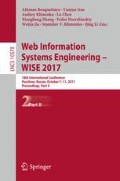Abstract
Recently, several approaches simultaneously exploiting ratings and review texts have been proposed for personalized recommendations. These approaches apply topic modeling techniques on review texts to mining major latent aspects of the item (or the user) and align them with collaborative filtering algorithms to increase the accuracy and interpretability of rating prediction. However, they learn the topics for each item (or user) by harnessing all reviews related to it, which is not intuitive or in line with users’ rating and review behavior. In this paper, we propose a Fine-grained Latent Aspects Model (FLAM), which learns the topics for each review with the corresponding latent aspect ratings of the user and the item. FLAM is an united model of Latent Factor Model (LFM) and Latent Dirichlet Allocation (LDA). LFM, well-known for its high prediction accuracy, is employed to predict latent aspect ratings of the user and the item. LDA, a classical topic model, is used to extract latent aspects in the reviews. Our experiment results on 25 real-world datasets show the proposed model has superiority over state-of-the-art methods and can learn the latent topics that are interpretable. Furthermore, our model can alleviate the cold-start problem.
References
Su, X., Khoshgoftaar, T.M.: A survey of collaborative filtering techniques. Adv. Artif. Intell. 2009, 4 (2009)
Yu, Y., Gao, Y., Wang, H., Wang, R.: Joint user knowledge and matrix factorization for recommender systems. In: Cellary, W., Mokbel, Mohamed F., Wang, J., Wang, H., Zhou, R., Zhang, Y. (eds.) WISE 2016. LNCS, vol. 10041, pp. 77–91. Springer, Cham (2016). doi:10.1007/978-3-319-48740-3_6
Bell, R.M., Koren, Y.: Lessons from the Netflix prize challenge. ACM SIGKDD Explor. Newsl. 9(2), 75–79 (2007)
Koren, Y., Bell, R., Volinsky, C.: Matrix factorization techniques for recommender systems. Computer 42(8), 30–37 (2009)
Koren, Y., Bell, R.: Advances in collaborative filtering. In: Ricci, F., Rokach, L., Shapira, B., Kantor, P. (eds.) Recommender Systems Handbook, pp. 145–186. Springer, Boston (2011). doi:10.1007/978-0-387-85820-3_5
Schein, A.I., Popescul, A., Ungar, L.H., Pennock, D.M.: Methods and metrics for cold-start recommendations. In: Proceedings of the 25th Annual International ACM SIGIR Conference on Research and Development in Information Retrieval, pp. 253–260. ACM (2002)
Ganu, G., Elhadad, N., Marian, A.: Beyond the stars: improving rating predictions using review text content. In: WebDB, vol. 9, pp. 1–6. Citeseer (2009)
Elhadad, S.: An unsupervised aspect-sentiment model for online reviews. In: Human Language Technologies: The 2010 Annual Conference of the North American Chapter of the Association for Computational Linguistics
Wang, H., Lu, Y., Zhai, C.: Latent aspect rating analysis on review text data: a rating regression approach. In: Proceedings of the 16th ACM SIGKDD International Conference on Knowledge Discovery and Data Mining, pp. 783–792. ACM (2010)
Wu, Y., Ester, M.: Flame: a probabilistic model combining aspect based opinion mining and collaborative filtering. In: Proceedings of the Eighth ACM International Conference on Web Search and Data Mining, pp. 199–208. ACM (2015)
Yin, H., Cui, B., Chen, L., Hu, Z., Zhou, X.: Dynamic user modeling in social media systems. ACM Trans. Inf. Syst. 33(3), 10:1–10:44 (2015)
He, X., Gao, M., Kan, M.Y., Liu, Y., Sugiyama, K.: Predicting the popularity of web 2.0 items based on user comments. In: Proceedings of the 37th International ACM SIGIR Conference on Research & Development in Information Retrieval, pp. 233–242. ACM (2014)
Zhang, Y., Lai, G., Zhang, M., Zhang, Y., Liu, Y., Ma, S.: Explicit factor models for explainable recommendation based on phrase-level sentiment analysis. In: Proceedings of the 37th International ACM SIGIR Conference on Research & Development in Information Retrieval, pp. 83–92. ACM (2014)
Bao, Y., Fang, H., Zhang, J.: TopicMF: simultaneously exploiting ratings and reviews for recommendation. In: AAAI, pp. 2–8 (2014)
Blei, D.M., Ng, A.Y., Jordan, M.I.: Latent dirichlet allocation. J. Mach. Learn. Res. 3, 993–1022 (2003)
Ding, C., Li, T., Peng, W., Park, H.: Orthogonal nonnegative matrix factorizations for clustering. In: Proceedings of the 12th ACM SIGKDD International Conference on Knowledge Discovery and Data Mining, pp. 126–135. ACM (2006)
Salakhutdinov, R., Mnih, A.: Probabilistic matrix factorization. In: NIPS, vol. 1, pp. 1–2 (2007)
Wang, C., Blei, D.M.: Collaborative topic modeling for recommending scientific articles. In: Proceedings of the 17th ACM SIGKDD International Conference on Knowledge Discovery and Data Mining, pp. 448–456. ACM (2011)
McAuley, J., Leskovec, J.: Hidden factors and hidden topics: understanding rating dimensions with review text. In: Proceedings of the 7th ACM Conference on Recommender Systems, pp. 165–172. ACM (2013)
Ling, G., Lyu, M.R., King, I.: Ratings meet reviews, a combined approach to recommend. In: Proceedings of the 8th ACM Conference on Recommender Systems, pp. 105–112. ACM (2014)
Jiang, M., Song, D., Liao, L., Zhu, F.: A Bayesian recommender model for user rating and review profiling. Tsinghua Sci. Technol. 20(6), 634–643 (2015)
Koren, Y.: Factorization meets the neighborhood: a multifaceted collaborative filtering model. In: Proceedings of the 14th ACM SIGKDD International Conference on Knowledge Discovery and Data Mining, pp. 426–434. ACM (2008)
Author information
Authors and Affiliations
Corresponding author
Editor information
Editors and Affiliations
Rights and permissions
Copyright information
© 2017 Springer International Publishing AG
About this paper
Cite this paper
Mao, X., Yuan, S., Xu, W., Wei, D. (2017). A Fine-Grained Latent Aspects Model for Recommendation: Combining Each Rating with Its Associated Review. In: Bouguettaya, A., et al. Web Information Systems Engineering – WISE 2017. WISE 2017. Lecture Notes in Computer Science(), vol 10570. Springer, Cham. https://doi.org/10.1007/978-3-319-68786-5_34
Download citation
DOI: https://doi.org/10.1007/978-3-319-68786-5_34
Published:
Publisher Name: Springer, Cham
Print ISBN: 978-3-319-68785-8
Online ISBN: 978-3-319-68786-5
eBook Packages: Computer ScienceComputer Science (R0)

